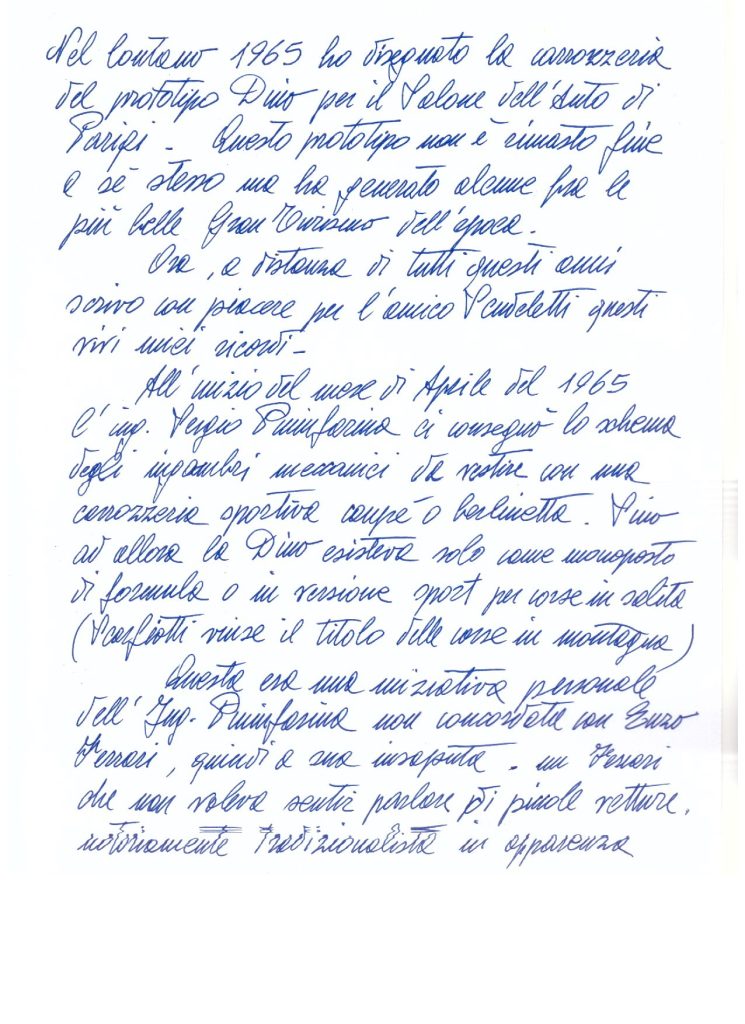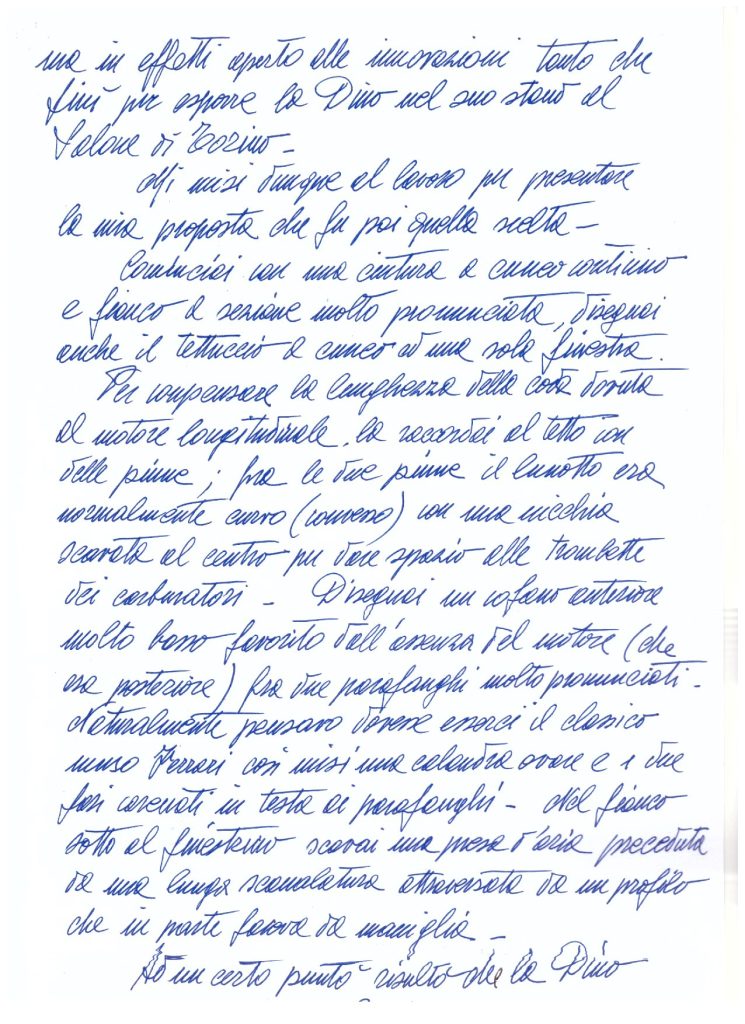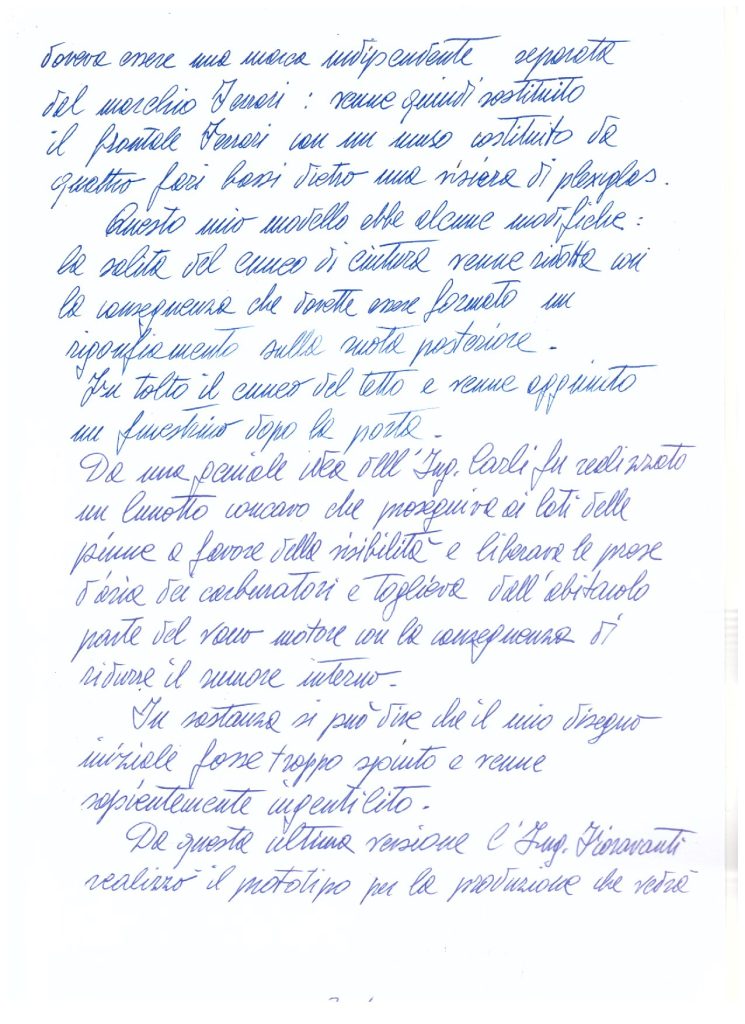
Quella delle vetture Dino è una tra le più belle storie automobilistiche in assoluto, una storia ambientata in Italia, tra Torino e Maranello, che segnerà una vero e proprio capitolo nel mondo delle corse su pista e in strada.
Una storia che ha coinvolto i più grandi maestri progettisti, designer, imprenditori e piloti di tutti i tempi.
Il 19 Gennaio del 1932 nasce Alfredo Ferrari, primogenito di Enzo, e deviare il percorso che suo padre immagina per lui è molto difficile ma riuscirà comunque a fuggire dalla grande ombra del maestro dei motori V12 per cercare nuove strade ingegneristiche.
Durante la prima metà degli anni 50, prima di ammalarsi di distrofia muscolare, Dino lavora insieme ad altri ingegneri, come Aurelio Lampredi, sui tecnigrafi nello stabilimento Ferrari a maranello ponendosi come obiettivo quello di effettuare uno studio di un motore V6
Purtroppo la distrofia peggiorerà e nel Giugno 1956 questa malattia lo porterà via lasciando un grande vuoto nel cuore di Enzo che, disperato, deciderà di nominare “Dino” quei motori V6 prodotti dalla Ferrari.
L’ingegner Jano proseguirà il lavoro di ricerca e sviluppo e durante lo stesso 1956 il primo motore V6 verrà messo su di un banco di prova, l’anno successivo nascerà la prima macchina con motore Dino, pronta per correre.
Dino darà inizio così ad una lunga storia di macchine da corsa e da strada con numerose partecipazioni a gare di ogni tipo.
Il primo traguardo rilevante verrà raggiunto nel 1958 quando Mike Hawthorn diventerà campione del mondo F1 al volante di una Dino 246 e qualche anno dopo con Phil Hill al volante di una 156, la “sharknose”.
Le Dino si faranno notare anche nelle gare in salita, vincendo campionati europei per ben tre volte con una Dino 196 S, 206 S e 206 P. Si susseguirono vittorie anche in F2 con De Adamich che diventerà campione nel 1968 nell’ abitacolo di una 166.
La decisione che la FIA prenderà nel 1964 per quanto riguarda la stagione del 1967 sarà il momento più significativo nella storia della Dino. Le nuove regole dicono che per correre in F2 nel 1967, ogni macchina deve essere equipaggiata da un motore già omologato e montato su un auto di serie e costruita in almeno 500 esemplari.
Per Ferrari sarà impossibile costruire così tante vetture in così poco tempo, dopo tutto era ancora una piccola azienda, allora inizierà un dialogo con la Innocenti per produrre una vettura con il motore V6, la 186 GT, che rimarrà solo un prototipo in 3 esemplari e non avrà vita.
Enzo Ferrari darà allora inizio ad un altro dialogo, con Giovanni Agnelli (presidente della FIAT), che culminerà in un accordo ufficialmente presentato alla stampa il 1° marzo 1965, dove Ferrari si impegnerà nel produrre i motori e la Fiat assemblerà le vetture, in modo da consentire l’omologazione in F2.
Il prodotto fu la Fiat Dino Spider 2000, messa in commercio fin da subito.
Il motore verrà dunque abilitato per la F2 nel 1967 e l’anno successivo vincerà il campionato del mondo.
Intanto Fiat presenta la sorella della spider, la Dino 2000 Coupè.
Nel 1969 verranno sostituite entrambe con la versione più moderna, le 2400, con la variazione di diversi aspetti tecnici ed estetici.
Facendo un salto indietro nel tempo, nel 1965, durante il salone di Parigi viene presentata la Dino Berlinetta Speciale, opera del maestro Aldo Brovarone, e per Pininfarina con la progettazione di Leonardo Fioravanti sarà la base di partenza per lo sviluppo della Dino 206 GT, seguita qualche anno dopo dalle Dino 246 GT e GTS, contemporaneamente nasce anche la Dino 206 Berlinetta Competizione di Paolo Martin.



ENGLISH
Dino cars is one of the most beautiful automotive stories ever, a story set in Italy, between Turin and Maranello, which will mark a real chapter in the world of track and racing.
A story that involved the greatest designers, engineers, entrepreneurs and drivers of all time.
On January 19, 1932, Alfredo Ferrari, Enzo’s first son, was born and changing the the car idea of the father was very difficult but he will manage to escape from the great shadow of the master of V12 engines to look for new engineering roads.
During the first half of the ’50s, before suffering from muscular dystrophy, Dino worked with other engineers, such as Aurelio Lampredi, on the technicians at the Ferrari factory in Maranello with the aim of carrying out a study of a V6 engine
Unfortunately the dystrophy will worsen and in June 1956 this disease will take him away leaving a big gap in the heart of Enzo who, desperate, will decide to name “Dino” those V6 engines produced by Ferrari.
Engineer Jano will continue the research and development work and during the same 1956 the first V6 engine will be put on a test bench, the following year the first car with Dino engine will be born, ready to race.
Dino will thus start a long history of racing and road cars with numerous participations in races of all kinds.
The first important milestone was reached in 1958 when Mike Hawthorn became F1 world champion at the wheel of a Dino 246 and a few years later with Phil Hill at the wheel of a 156, the “sharknose”.
The Dino will be noticed in the uphill races, winning European championships three times with a Dino 196 S, 206 S and 206 P. There were also victories in F2 with De Adamich who became champion in 1968 in the cockpit of a 166.
The decision that the FIA will take in 1964 regarding the 1967 season will be the most significant moment in the history of Dino. The new rules say that to run in F2 in 1967, every car must be equipped with an engine already homologated and mounted on a series car and built in at least 500 units.
For Ferrari it will be impossible to build so many cars in such a short time, after all it was still a small company, then it will start a dialogue with the Innocenti to produce a car with the V6 engine, the 186 GT, which will remain only a prototype in 3 specimens and will not have life.
Enzo Ferrari will then start another dialogue, with Giovanni Agnelli (president of FIAT), which will culminate in an agreement officially presented to the press on 1 March 1965, where Ferrari will be engaged in producing engines and Fiat will assemble the cars, in order to allow approval in F2.
The product was the Fiat Dino Spider 2000, put on the market immediately.
The engine will then be enabled for the F2 in 1967 and the following year will win the world championship.
Meanwhile Fiat presents the sister of the spider, the Dino 2000 Coupe.
In 1969 both will be replaced with the more modern version, the 2400, with the variation of different technical and aesthetic aspects.
Taking a step back in time, in 1965, during the Paris Show was presented the Dino Berlinetta Speciale, the work of master Aldo Brovarone, and for Pininfarina with the design of Leonardo Fioravanti will be the starting point for the development of the Dino 206 GT, followed a few years later by the Dino 246 GT and GTS, at the same time the Dino 206 Berlinetta Competizione by Paolo Martin was born.
CONTATTACI – CONTACT US
CLUB DINO ITALIA
Brembate di Sopra (BG)
info@clubdinoitalia.it